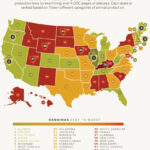As we delve into the intricate judicial landscapes of animal cruelty laws, a pressing inquiry emerges: What exactly are the current penalties for animal cruelty in Michigan and Idaho? Understanding the repercussions of cruelty towards animals is essential for fostering a society that values compassion over neglect. It allows us to scrutinize our legal frameworks and advocate for necessary reforms that safeguard the most vulnerable members of our society. But first, let us define what constitutes animal cruelty and the legal implications in both of these states.
Animal cruelty, broadly defined, encompasses any act that inflicts unnecessary suffering or harm upon animals. This could range from overt acts of violence to neglect and abandonment. Both Michigan and Idaho have established laws to deter such conduct; however, the severity of penalties and the classification of offenses can vary significantly.
In Michigan, animal cruelty is governed by the Animal Protection Act. Offenses are categorized into two distinct levels: misdemeanors and felonies. A first-time offender may find themselves charged with a misdemeanor for acts that cause minor harm to an animal. This offense carries a penalty of up to 93 days in jail and/or a fine not exceeding $1,000. Yet, as the severity of the offense escalates, so too do the penalties.
On the other end of the spectrum, egregious acts of cruelty, such as severe physical abuse or systematic neglect leading to the suffering or death of an animal, can lead to felony charges. A felony conviction can result in a prison sentence of up to five years and/or hefty fines reaching $5,000. Michigan law also allows for restitution to be paid for the care of animals during the investigation, further emphasizing the state’s commitment to protecting animal welfare.
Idaho’s statutes reveal a slightly different approach. In this state, the laws surrounding animal cruelty are equally serious but exhibit notable differences in enforcement and penalties. Idaho classifies animal cruelty into two categories: misdemeanor and felony, much like Michigan. However, Idaho is distinctive in its application of these laws regarding agricultural animals. For many ranchers and farmers, the application of animal welfare laws often intermingles with their daily practices, leading to unique challenges.
A standard act of cruelty in Idaho can lead to misdemeanor charges, resulting in penalties that may include up to six months of incarceration and fines that can reach $5,000. As in Michigan, a more heinous act—defined as one that leads to severe injury or death of an animal—can escalate charges to a felony. Felony convictions in Idaho can yield up to five years of imprisonment and substantial fines. Yet, it is crucial to note that Idaho has historically faced challenges in enforcing these laws uniformly, often due to rural perspectives that prioritize agricultural practices over animal welfare considerations.
The differences between these states prompt us to pose a playful question: Is the legal framework a sufficient deterrent against acts of cruelty? Can we confidently assert that the existing penalties serve their intended purpose? Challenges abound as advocates argue that penalties in both states remain insufficient to curtail the brutality and neglect that animals endure. The fear of legal ramifications alone does not always dissuade individuals from engaging in harmful practices.
The advocacy for stricter penalties is further fueled by the perception that current laws do not adequately address the nuances and complexities of animal welfare. For example, organizations dedicated to animal rights constantly lobby for enhanced legislation that encompasses psychological distress or chronic neglect—areas often overlooked in legal assessments. Moreover, the lack of requisite training for law enforcement officers and the judicial system in recognizing signs of animal cruelty further complicates these issues.
One of the key challenges in animal cruelty legislation is the public’s understanding—or misunderstanding—of what cruelty entails. Not all acts of neglect are immediately apparent. For instance, failing to provide adequate medical care, nutrition, or shelter can be more insidious forms of cruelty that are not always recognized under current statutes. Herein lies the conundrum: how can society effectively advocate for animals if the defining parameters of cruelty remain ambiguous? Educating the public about these subtleties will be critical in shifting perceptions and influencing legislative change.
Furthermore, as the spotlight on animal rights grows, so does the need for community involvement in reporting suspected cruelty. Transparency and accountability can only thrive in environments where citizens feel empowered to take action. It is vital that communities foster a culture where animal welfare is prioritized and where reporting cruelty is viewed as a civic duty rather than a nuisance. With increased vigilance, we may very well catalyze significant reforms in the prevailing legal frameworks governing animal welfare.
In conclusion, the current penalties for animal cruelty in Michigan and Idaho reflect a broader societal struggle with how we assess the value of animal lives. Although laws exist to penalize cruelty, many argue that these penalties must evolve to truly safeguard animals. Both Michigan and Idaho offer frameworks that, while containing provisions for punishment, reveal significant gaps needing urgent attention. As we confront these challenges, it becomes clear that the fight against animal cruelty is not merely a legal issue; it is a moral one, demanding our collective engagement and advocacy for change.







